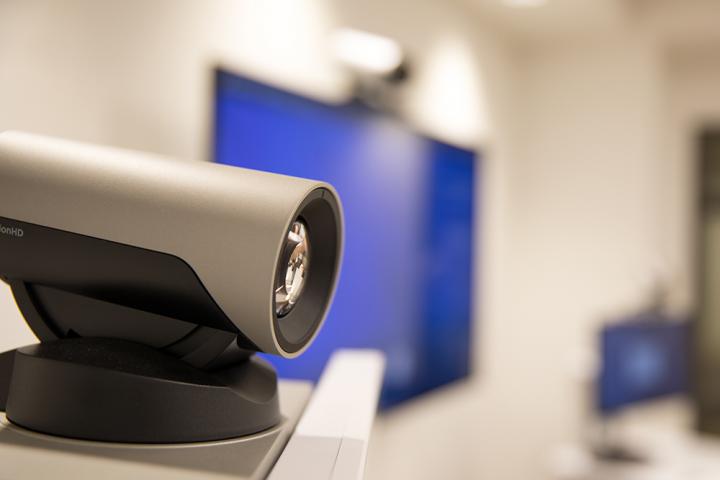In a quest to create a one-stop telehealth solution, Ignis Health, which has developed a robust telehealth analytics platform, licenses a roadmap for telehealth implementation from the Medical University of South Carolina

Credit: Medical University of South Carolina
The Medical University of South Carolina and Ignis Health share a common goal – improving telehealth. Earlier this month, Ignis licensed the Telehealth Service Implementation Model (TSIM), a roadmap for setting up a telehealth program developed by Shawn Valenta, former administrator for the MUSC Health Center for Telehealth, and other telehealth experts at MUSC. Ignis, which has a robust analytics platform known as the Telehealth Resource Program (TRP), has enhanced TSIM with robust TRP performance dashboards to create a complete software solution for hospitals and health care systems interested in expanding their telehealth services.
TSIM was born from MUSC’s own experience with launching telehealth services. An early adopter of telehealth, MUSC is now one of only two federally designated telehealth centers of excellence in the nation. The MUSC Health Center for Telehealth, headquarters of the South Carolina Telehealth Alliance, offers a wide variety of telehealth programs across the state.
However, like other institutions, MUSC felt growing pains when, in 2013, it began to rapidly ramp up its telehealth efforts rapidly. Programs that had grown up organically across different specialties did not always share the same technology or workflows. Valenta was charged with uniting these individual telehealth programs into a cohesive center, standardizing processes and aligning missions.
“As we pushed forward, we started having a lot of telehealth service development and implementation challenges,” said Valenta, who is now vice president of the Clinical Hub for WellPath. “There was variability in how we created services, which created operational support challenges. There was no existing framework that took you from the telehealth idea, through development, through implementation and through long-term sustainability of a telehealth service.”
Over the past few years, Valenta and others at the Center for Telehealth developed TSIM, a comprehensive guide on how to develop, implement and sustain telehealth services. TSIM is a dynamic system that can be used by a small hospital to develop a couple of telehealth programs or by a large health system to implement enterprisewide telehealth services.
“Telehealth might sound basic, but it’s more than just enabling video,” explained Valenta. “It involves a lot of modalities and covers multiple specialties. With TSIM, you have a roadmap for everyone on your team to follow the necessary steps for each of the specialties and each of the modalities you are trying to implement.”
It was Valenta’s presentation about TSIM at a telehealth conference that caught the attention of Najib Ben Brahim, Ph.D., founder and CEO of Ignis Health. Ignis had developed the telehealth data analytics platform, TRP, which provides robust metrics to measure the success of telehealth efforts.
“TRP measures the telehealth performance and activity across the enterprise,” explained Ben Brahim. “It does that through a comprehensive overview of what is going on from an operational standpoint and a financial standpoint. We also assess clinical quality along the way.”
Ben Brahim immediately recognized the potential synergy between TSIM and TRP and reached out to Valenta, who was eager to join forces. In early October, Ignis licensed TSIM from MUSC’s Foundation for Research Development. Valenta and Ben Brahim believe that the synergies between the two platforms can propel telehealth initiatives forward. TSIM provides a blueprint for implementation of telehealth while TRP is a means to monitor the success of telehealth efforts.
“Putting TSIM and TRP together could be the holy grail of telehealth development,” said Valenta. “TSIM provides a standardized way to develop a service efficiently and effectively and monitor and track performance, and TRP provides a robust data index.”
The TRP-enhanced TSIM software solution has much to offer the many health systems that expanded telehealth during the pandemic but may not know how best to sustain and grow those efforts.
“The big promise of telehealth is completely redesigning the way care is delivered in a more efficient, effective way,” said Valenta. “That means you must determine the goals of delivering the service, and you may have to redesign completely what that care is. Without the framework to do it in an effective, standardized way, people will make costly mistakes.”
At the end of the day, Valenta and Ben Brahim are motivated and inspired by the most important aspect of telehealth – the patient. Their close collaboration is helping them to realize their number one goal – providing people with access to high-quality and cost-effective health care.
###
About MUSC
Founded in 1824 in Charleston, MUSC is the oldest medical school in the South, as well as the state’s only integrated, academic health sciences center with a unique charge to serve the state through education, research and patient care. Each year, MUSC educates and trains more than 3,000 students and nearly 800 residents in six colleges: Dental Medicine, Graduate Studies, Health Professions, Medicine, Nursing and Pharmacy. The state’s leader in obtaining biomedical research funds, in fiscal year 2019, MUSC set a new high, bringing in more than $284 million. For information on academic programs, visit musc.edu.
As the clinical health system of the Medical University of South Carolina, MUSC Health is dedicated to delivering the highest quality patient care available, while training generations of competent, compassionate health care providers to serve the people of South Carolina and beyond. Comprising some 1,600 beds, more than 100 outreach sites, the MUSC College of Medicine, the physicians’ practice plan, and nearly 275 telehealth locations, MUSC Health owns and operates eight hospitals situated in Charleston, Chester, Florence, Lancaster and Marion counties. In 2019, for the fifth consecutive year, U.S. News & World Report named MUSC Health the No. 1 hospital in South Carolina. To learn more about clinical patient services, visit muschealth.org.
MUSC and its affiliates have collective annual budgets of $3.2 billion. The more than 17,000 MUSC team members include world-class faculty, physicians, specialty providers and scientists who deliver groundbreaking education, research, technology and patient care.
About the MUSC Foundation for Research Development
The MUSC Foundation for Research Development is responsible for evaluating all intellectual assets the enterprise owns and generates, extracting value and forging industry and other relationships, resulting in products and services that provide real-life solutions to the world’s medical needs. Whether our translations involve a technology license, research collaboration or new startup venture, we serve as a dedicated one-stop shop for advancing innovation at MUSC. Our team is also dedicated to building an ecosystem of innovation the activities of which contribute to MUSC’s overall economic impact on our state and country. Please visit us online at http://www.
About Ignis Health
Ignis Health provides the framework for quality telehealth programs by enabling healthcare-specific project management and analytics solutions. Through streamlined and standardized workflows, Ignis Health enables quick and efficient service creation and completion to achieve project milestones when setting up telehealth programs. Our analytics solution measures the efficacy and ROI of existing telehealth programs by overlaying clinical intelligence on top of telehealth metrics. To learn more, visit https:/
Media Contact
Heather Woolwine
[email protected]
Original Source
https:/




